Annotated Bibliography: Hate Crime Victimisation in the United Kingdom
VerifiedAdded on 2022/08/23
|8
|1944
|46
Annotated Bibliography
AI Summary
This annotated bibliography examines three journal articles related to hate crime victimisation in the United Kingdom. The first article, by Donovan, Clayton, and Macdonald (2019), investigates hate crime reporting, focusing on sexuality, transgender identities, and the role of social inequalities. The second article, by Farrington and Jolliffe (2019), provides an account of the demographics and criminal histories of hate crime offenders in the UK, highlighting the prolific criminal careers of those incarcerated for hate crimes. The third article, by Mason and Moran (2019), explores the challenges faced by law enforcement agencies in addressing bias crimes, comparing approaches in the UK and Australia. The bibliography provides a comprehensive overview of research on hate crime, covering reporting, offender characteristics, and policing strategies, and it provides key insights into the complexities of hate crime in the UK context.
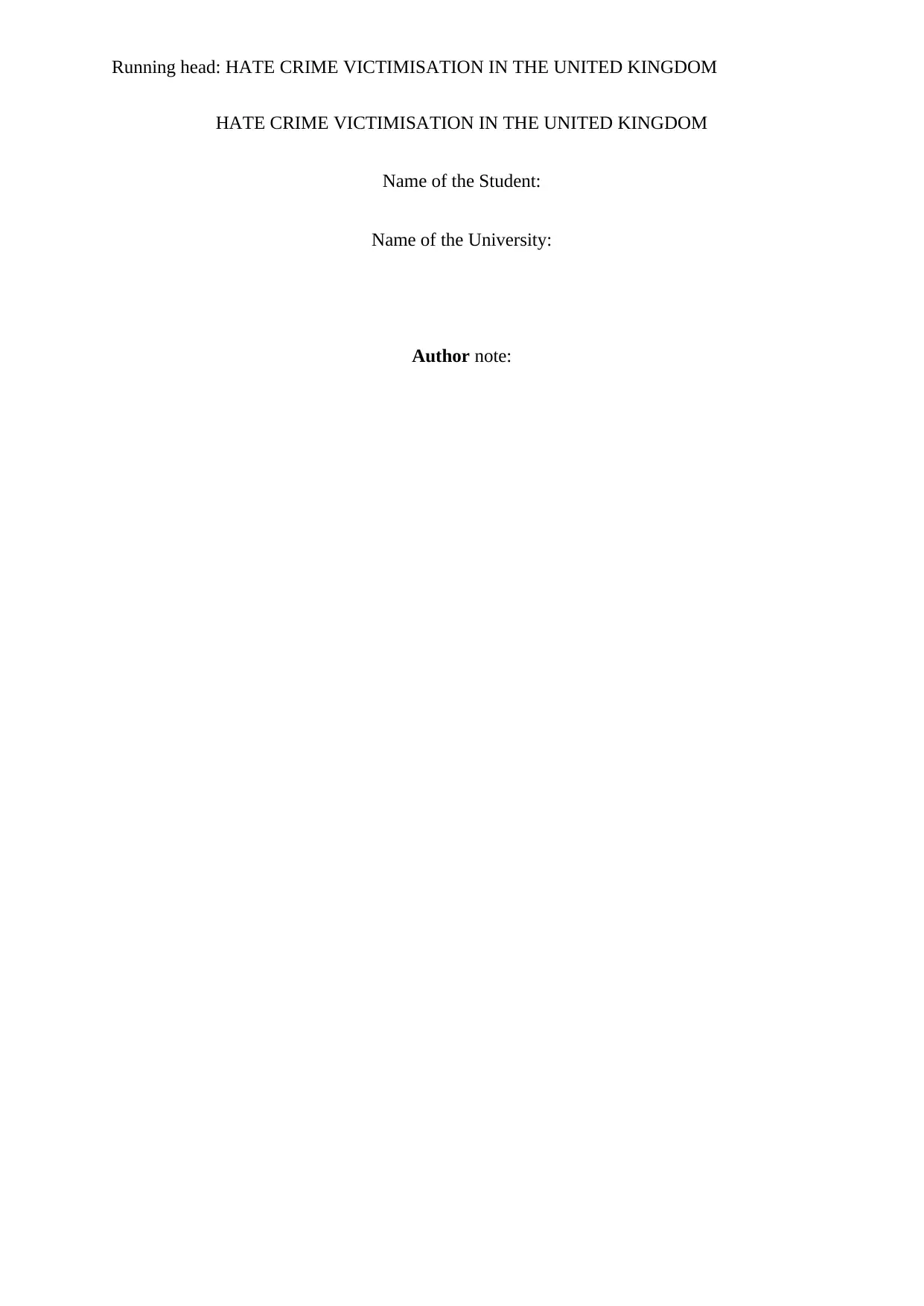
Running head: HATE CRIME VICTIMISATION IN THE UNITED KINGDOM
HATE CRIME VICTIMISATION IN THE UNITED KINGDOM
Name of the Student:
Name of the University:
Author note:
HATE CRIME VICTIMISATION IN THE UNITED KINGDOM
Name of the Student:
Name of the University:
Author note:
Paraphrase This Document
Need a fresh take? Get an instant paraphrase of this document with our AI Paraphraser
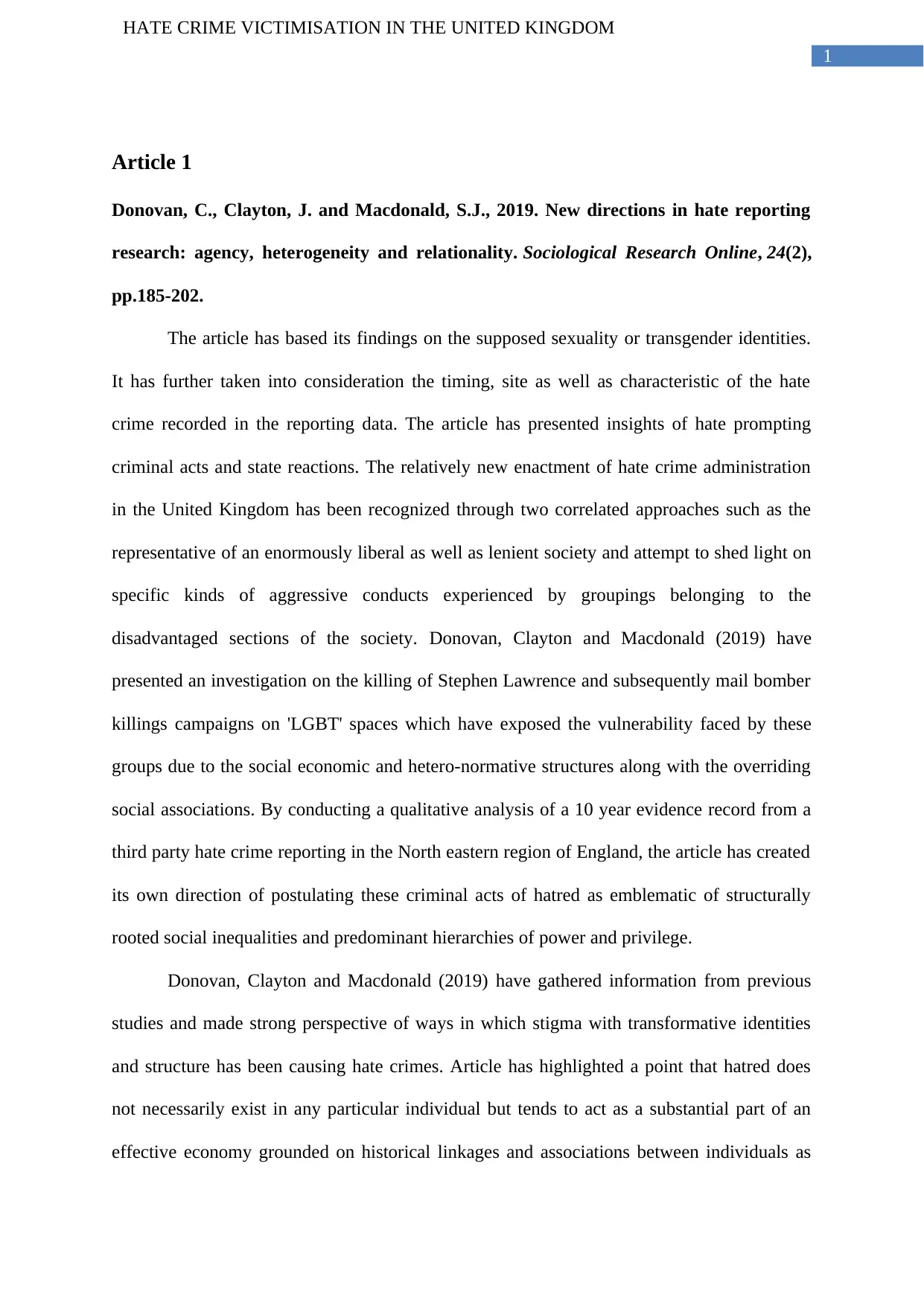
1
HATE CRIME VICTIMISATION IN THE UNITED KINGDOM
Article 1
Donovan, C., Clayton, J. and Macdonald, S.J., 2019. New directions in hate reporting
research: agency, heterogeneity and relationality. Sociological Research Online, 24(2),
pp.185-202.
The article has based its findings on the supposed sexuality or transgender identities.
It has further taken into consideration the timing, site as well as characteristic of the hate
crime recorded in the reporting data. The article has presented insights of hate prompting
criminal acts and state reactions. The relatively new enactment of hate crime administration
in the United Kingdom has been recognized through two correlated approaches such as the
representative of an enormously liberal as well as lenient society and attempt to shed light on
specific kinds of aggressive conducts experienced by groupings belonging to the
disadvantaged sections of the society. Donovan, Clayton and Macdonald (2019) have
presented an investigation on the killing of Stephen Lawrence and subsequently mail bomber
killings campaigns on 'LGBT' spaces which have exposed the vulnerability faced by these
groups due to the social economic and hetero-normative structures along with the overriding
social associations. By conducting a qualitative analysis of a 10 year evidence record from a
third party hate crime reporting in the North eastern region of England, the article has created
its own direction of postulating these criminal acts of hatred as emblematic of structurally
rooted social inequalities and predominant hierarchies of power and privilege.
Donovan, Clayton and Macdonald (2019) have gathered information from previous
studies and made strong perspective of ways in which stigma with transformative identities
and structure has been causing hate crimes. Article has highlighted a point that hatred does
not necessarily exist in any particular individual but tends to act as a substantial part of an
effective economy grounded on historical linkages and associations between individuals as
HATE CRIME VICTIMISATION IN THE UNITED KINGDOM
Article 1
Donovan, C., Clayton, J. and Macdonald, S.J., 2019. New directions in hate reporting
research: agency, heterogeneity and relationality. Sociological Research Online, 24(2),
pp.185-202.
The article has based its findings on the supposed sexuality or transgender identities.
It has further taken into consideration the timing, site as well as characteristic of the hate
crime recorded in the reporting data. The article has presented insights of hate prompting
criminal acts and state reactions. The relatively new enactment of hate crime administration
in the United Kingdom has been recognized through two correlated approaches such as the
representative of an enormously liberal as well as lenient society and attempt to shed light on
specific kinds of aggressive conducts experienced by groupings belonging to the
disadvantaged sections of the society. Donovan, Clayton and Macdonald (2019) have
presented an investigation on the killing of Stephen Lawrence and subsequently mail bomber
killings campaigns on 'LGBT' spaces which have exposed the vulnerability faced by these
groups due to the social economic and hetero-normative structures along with the overriding
social associations. By conducting a qualitative analysis of a 10 year evidence record from a
third party hate crime reporting in the North eastern region of England, the article has created
its own direction of postulating these criminal acts of hatred as emblematic of structurally
rooted social inequalities and predominant hierarchies of power and privilege.
Donovan, Clayton and Macdonald (2019) have gathered information from previous
studies and made strong perspective of ways in which stigma with transformative identities
and structure has been causing hate crimes. Article has highlighted a point that hatred does
not necessarily exist in any particular individual but tends to act as a substantial part of an
effective economy grounded on historical linkages and associations between individuals as
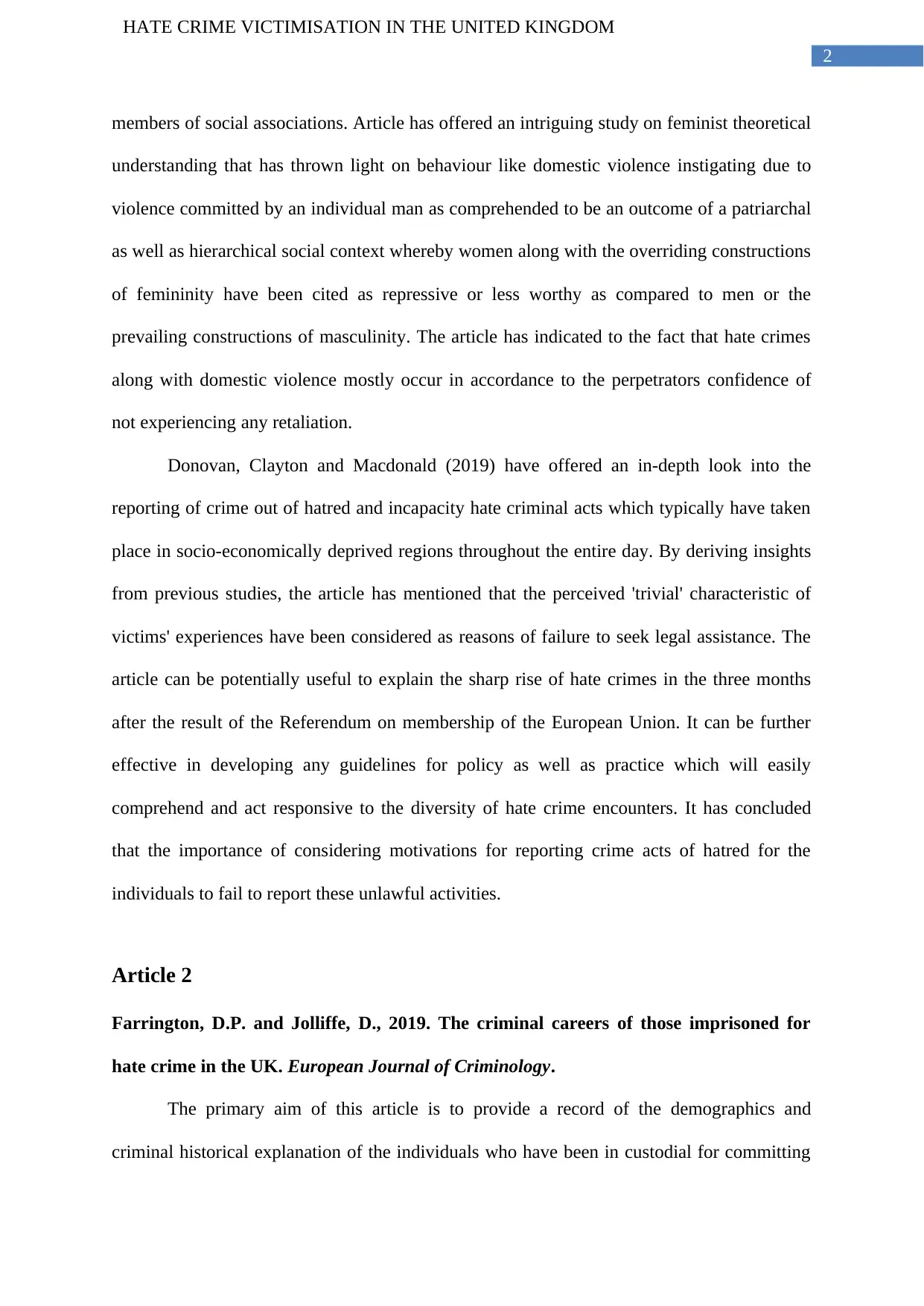
2
HATE CRIME VICTIMISATION IN THE UNITED KINGDOM
members of social associations. Article has offered an intriguing study on feminist theoretical
understanding that has thrown light on behaviour like domestic violence instigating due to
violence committed by an individual man as comprehended to be an outcome of a patriarchal
as well as hierarchical social context whereby women along with the overriding constructions
of femininity have been cited as repressive or less worthy as compared to men or the
prevailing constructions of masculinity. The article has indicated to the fact that hate crimes
along with domestic violence mostly occur in accordance to the perpetrators confidence of
not experiencing any retaliation.
Donovan, Clayton and Macdonald (2019) have offered an in-depth look into the
reporting of crime out of hatred and incapacity hate criminal acts which typically have taken
place in socio-economically deprived regions throughout the entire day. By deriving insights
from previous studies, the article has mentioned that the perceived 'trivial' characteristic of
victims' experiences have been considered as reasons of failure to seek legal assistance. The
article can be potentially useful to explain the sharp rise of hate crimes in the three months
after the result of the Referendum on membership of the European Union. It can be further
effective in developing any guidelines for policy as well as practice which will easily
comprehend and act responsive to the diversity of hate crime encounters. It has concluded
that the importance of considering motivations for reporting crime acts of hatred for the
individuals to fail to report these unlawful activities.
Article 2
Farrington, D.P. and Jolliffe, D., 2019. The criminal careers of those imprisoned for
hate crime in the UK. European Journal of Criminology.
The primary aim of this article is to provide a record of the demographics and
criminal historical explanation of the individuals who have been in custodial for committing
HATE CRIME VICTIMISATION IN THE UNITED KINGDOM
members of social associations. Article has offered an intriguing study on feminist theoretical
understanding that has thrown light on behaviour like domestic violence instigating due to
violence committed by an individual man as comprehended to be an outcome of a patriarchal
as well as hierarchical social context whereby women along with the overriding constructions
of femininity have been cited as repressive or less worthy as compared to men or the
prevailing constructions of masculinity. The article has indicated to the fact that hate crimes
along with domestic violence mostly occur in accordance to the perpetrators confidence of
not experiencing any retaliation.
Donovan, Clayton and Macdonald (2019) have offered an in-depth look into the
reporting of crime out of hatred and incapacity hate criminal acts which typically have taken
place in socio-economically deprived regions throughout the entire day. By deriving insights
from previous studies, the article has mentioned that the perceived 'trivial' characteristic of
victims' experiences have been considered as reasons of failure to seek legal assistance. The
article can be potentially useful to explain the sharp rise of hate crimes in the three months
after the result of the Referendum on membership of the European Union. It can be further
effective in developing any guidelines for policy as well as practice which will easily
comprehend and act responsive to the diversity of hate crime encounters. It has concluded
that the importance of considering motivations for reporting crime acts of hatred for the
individuals to fail to report these unlawful activities.
Article 2
Farrington, D.P. and Jolliffe, D., 2019. The criminal careers of those imprisoned for
hate crime in the UK. European Journal of Criminology.
The primary aim of this article is to provide a record of the demographics and
criminal historical explanation of the individuals who have been in custodial for committing
⊘ This is a preview!⊘
Do you want full access?
Subscribe today to unlock all pages.

Trusted by 1+ million students worldwide
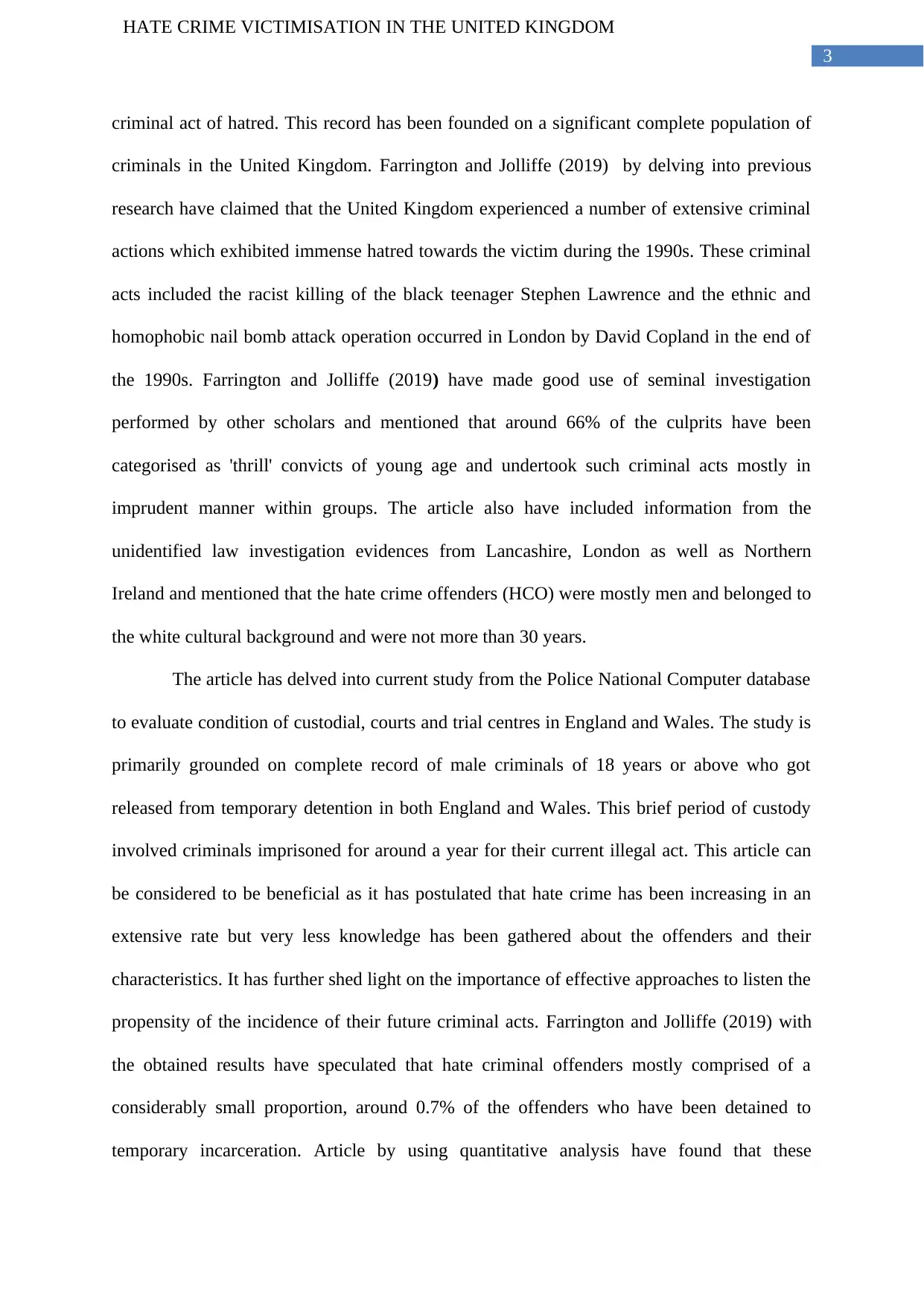
3
HATE CRIME VICTIMISATION IN THE UNITED KINGDOM
criminal act of hatred. This record has been founded on a significant complete population of
criminals in the United Kingdom. Farrington and Jolliffe (2019) by delving into previous
research have claimed that the United Kingdom experienced a number of extensive criminal
actions which exhibited immense hatred towards the victim during the 1990s. These criminal
acts included the racist killing of the black teenager Stephen Lawrence and the ethnic and
homophobic nail bomb attack operation occurred in London by David Copland in the end of
the 1990s. Farrington and Jolliffe (2019) have made good use of seminal investigation
performed by other scholars and mentioned that around 66% of the culprits have been
categorised as 'thrill' convicts of young age and undertook such criminal acts mostly in
imprudent manner within groups. The article also have included information from the
unidentified law investigation evidences from Lancashire, London as well as Northern
Ireland and mentioned that the hate crime offenders (HCO) were mostly men and belonged to
the white cultural background and were not more than 30 years.
The article has delved into current study from the Police National Computer database
to evaluate condition of custodial, courts and trial centres in England and Wales. The study is
primarily grounded on complete record of male criminals of 18 years or above who got
released from temporary detention in both England and Wales. This brief period of custody
involved criminals imprisoned for around a year for their current illegal act. This article can
be considered to be beneficial as it has postulated that hate crime has been increasing in an
extensive rate but very less knowledge has been gathered about the offenders and their
characteristics. It has further shed light on the importance of effective approaches to listen the
propensity of the incidence of their future criminal acts. Farrington and Jolliffe (2019) with
the obtained results have speculated that hate criminal offenders mostly comprised of a
considerably small proportion, around 0.7% of the offenders who have been detained to
temporary incarceration. Article by using quantitative analysis have found that these
HATE CRIME VICTIMISATION IN THE UNITED KINGDOM
criminal act of hatred. This record has been founded on a significant complete population of
criminals in the United Kingdom. Farrington and Jolliffe (2019) by delving into previous
research have claimed that the United Kingdom experienced a number of extensive criminal
actions which exhibited immense hatred towards the victim during the 1990s. These criminal
acts included the racist killing of the black teenager Stephen Lawrence and the ethnic and
homophobic nail bomb attack operation occurred in London by David Copland in the end of
the 1990s. Farrington and Jolliffe (2019) have made good use of seminal investigation
performed by other scholars and mentioned that around 66% of the culprits have been
categorised as 'thrill' convicts of young age and undertook such criminal acts mostly in
imprudent manner within groups. The article also have included information from the
unidentified law investigation evidences from Lancashire, London as well as Northern
Ireland and mentioned that the hate crime offenders (HCO) were mostly men and belonged to
the white cultural background and were not more than 30 years.
The article has delved into current study from the Police National Computer database
to evaluate condition of custodial, courts and trial centres in England and Wales. The study is
primarily grounded on complete record of male criminals of 18 years or above who got
released from temporary detention in both England and Wales. This brief period of custody
involved criminals imprisoned for around a year for their current illegal act. This article can
be considered to be beneficial as it has postulated that hate crime has been increasing in an
extensive rate but very less knowledge has been gathered about the offenders and their
characteristics. It has further shed light on the importance of effective approaches to listen the
propensity of the incidence of their future criminal acts. Farrington and Jolliffe (2019) with
the obtained results have speculated that hate criminal offenders mostly comprised of a
considerably small proportion, around 0.7% of the offenders who have been detained to
temporary incarceration. Article by using quantitative analysis have found that these
Paraphrase This Document
Need a fresh take? Get an instant paraphrase of this document with our AI Paraphraser
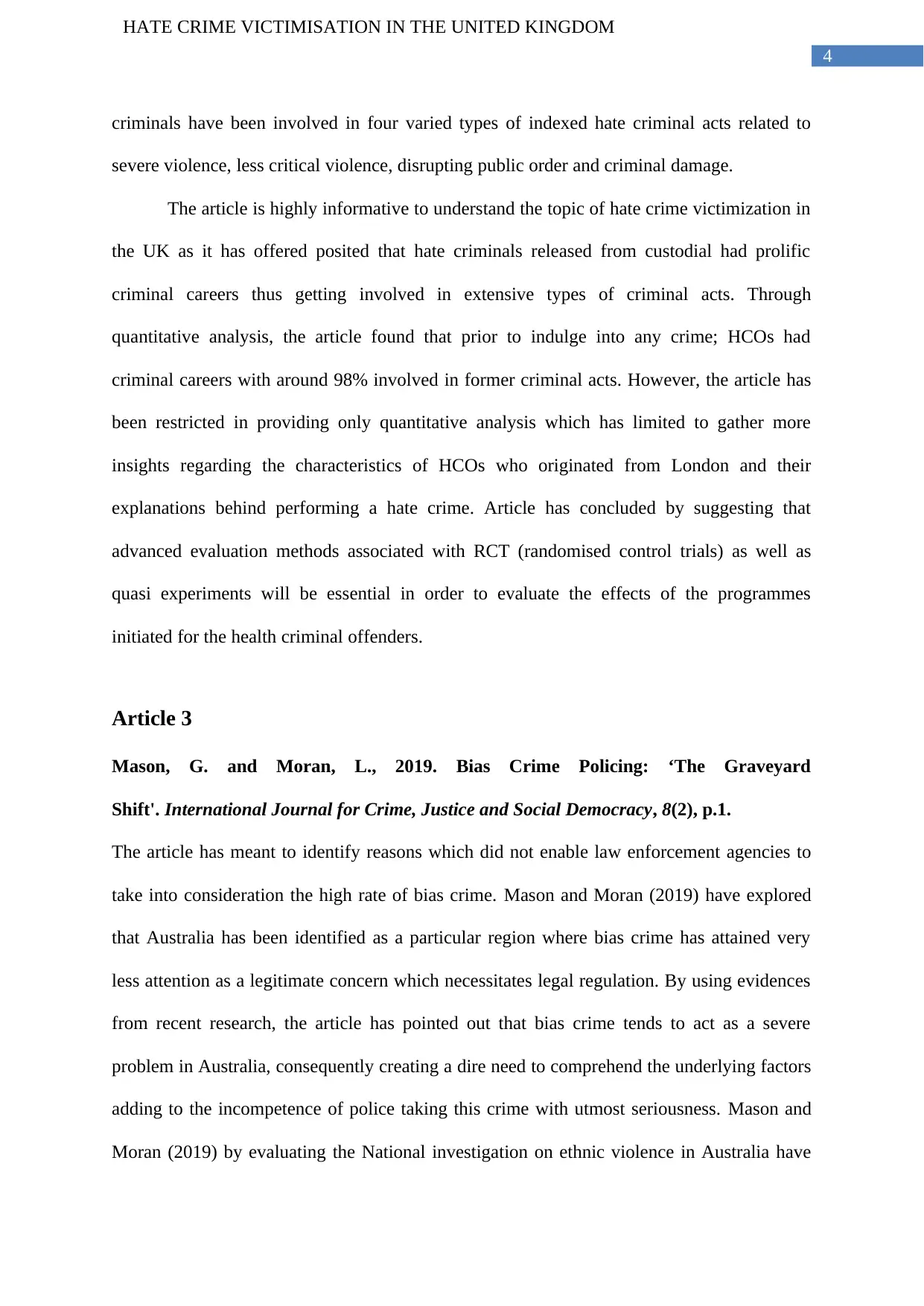
4
HATE CRIME VICTIMISATION IN THE UNITED KINGDOM
criminals have been involved in four varied types of indexed hate criminal acts related to
severe violence, less critical violence, disrupting public order and criminal damage.
The article is highly informative to understand the topic of hate crime victimization in
the UK as it has offered posited that hate criminals released from custodial had prolific
criminal careers thus getting involved in extensive types of criminal acts. Through
quantitative analysis, the article found that prior to indulge into any crime; HCOs had
criminal careers with around 98% involved in former criminal acts. However, the article has
been restricted in providing only quantitative analysis which has limited to gather more
insights regarding the characteristics of HCOs who originated from London and their
explanations behind performing a hate crime. Article has concluded by suggesting that
advanced evaluation methods associated with RCT (randomised control trials) as well as
quasi experiments will be essential in order to evaluate the effects of the programmes
initiated for the health criminal offenders.
Article 3
Mason, G. and Moran, L., 2019. Bias Crime Policing: ‘The Graveyard
Shift'. International Journal for Crime, Justice and Social Democracy, 8(2), p.1.
The article has meant to identify reasons which did not enable law enforcement agencies to
take into consideration the high rate of bias crime. Mason and Moran (2019) have explored
that Australia has been identified as a particular region where bias crime has attained very
less attention as a legitimate concern which necessitates legal regulation. By using evidences
from recent research, the article has pointed out that bias crime tends to act as a severe
problem in Australia, consequently creating a dire need to comprehend the underlying factors
adding to the incompetence of police taking this crime with utmost seriousness. Mason and
Moran (2019) by evaluating the National investigation on ethnic violence in Australia have
HATE CRIME VICTIMISATION IN THE UNITED KINGDOM
criminals have been involved in four varied types of indexed hate criminal acts related to
severe violence, less critical violence, disrupting public order and criminal damage.
The article is highly informative to understand the topic of hate crime victimization in
the UK as it has offered posited that hate criminals released from custodial had prolific
criminal careers thus getting involved in extensive types of criminal acts. Through
quantitative analysis, the article found that prior to indulge into any crime; HCOs had
criminal careers with around 98% involved in former criminal acts. However, the article has
been restricted in providing only quantitative analysis which has limited to gather more
insights regarding the characteristics of HCOs who originated from London and their
explanations behind performing a hate crime. Article has concluded by suggesting that
advanced evaluation methods associated with RCT (randomised control trials) as well as
quasi experiments will be essential in order to evaluate the effects of the programmes
initiated for the health criminal offenders.
Article 3
Mason, G. and Moran, L., 2019. Bias Crime Policing: ‘The Graveyard
Shift'. International Journal for Crime, Justice and Social Democracy, 8(2), p.1.
The article has meant to identify reasons which did not enable law enforcement agencies to
take into consideration the high rate of bias crime. Mason and Moran (2019) have explored
that Australia has been identified as a particular region where bias crime has attained very
less attention as a legitimate concern which necessitates legal regulation. By using evidences
from recent research, the article has pointed out that bias crime tends to act as a severe
problem in Australia, consequently creating a dire need to comprehend the underlying factors
adding to the incompetence of police taking this crime with utmost seriousness. Mason and
Moran (2019) by evaluating the National investigation on ethnic violence in Australia have
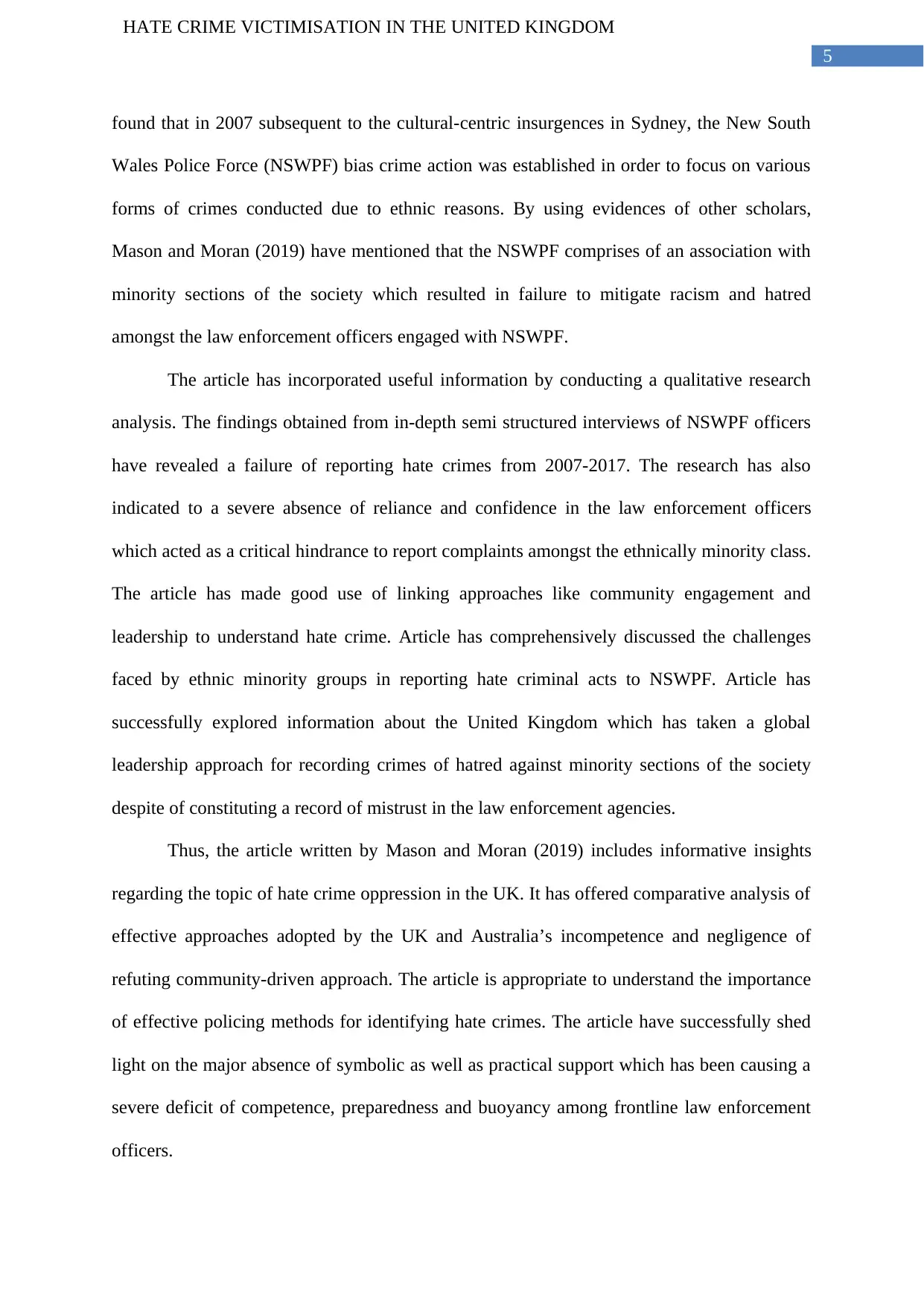
5
HATE CRIME VICTIMISATION IN THE UNITED KINGDOM
found that in 2007 subsequent to the cultural-centric insurgences in Sydney, the New South
Wales Police Force (NSWPF) bias crime action was established in order to focus on various
forms of crimes conducted due to ethnic reasons. By using evidences of other scholars,
Mason and Moran (2019) have mentioned that the NSWPF comprises of an association with
minority sections of the society which resulted in failure to mitigate racism and hatred
amongst the law enforcement officers engaged with NSWPF.
The article has incorporated useful information by conducting a qualitative research
analysis. The findings obtained from in-depth semi structured interviews of NSWPF officers
have revealed a failure of reporting hate crimes from 2007-2017. The research has also
indicated to a severe absence of reliance and confidence in the law enforcement officers
which acted as a critical hindrance to report complaints amongst the ethnically minority class.
The article has made good use of linking approaches like community engagement and
leadership to understand hate crime. Article has comprehensively discussed the challenges
faced by ethnic minority groups in reporting hate criminal acts to NSWPF. Article has
successfully explored information about the United Kingdom which has taken a global
leadership approach for recording crimes of hatred against minority sections of the society
despite of constituting a record of mistrust in the law enforcement agencies.
Thus, the article written by Mason and Moran (2019) includes informative insights
regarding the topic of hate crime oppression in the UK. It has offered comparative analysis of
effective approaches adopted by the UK and Australia’s incompetence and negligence of
refuting community-driven approach. The article is appropriate to understand the importance
of effective policing methods for identifying hate crimes. The article have successfully shed
light on the major absence of symbolic as well as practical support which has been causing a
severe deficit of competence, preparedness and buoyancy among frontline law enforcement
officers.
HATE CRIME VICTIMISATION IN THE UNITED KINGDOM
found that in 2007 subsequent to the cultural-centric insurgences in Sydney, the New South
Wales Police Force (NSWPF) bias crime action was established in order to focus on various
forms of crimes conducted due to ethnic reasons. By using evidences of other scholars,
Mason and Moran (2019) have mentioned that the NSWPF comprises of an association with
minority sections of the society which resulted in failure to mitigate racism and hatred
amongst the law enforcement officers engaged with NSWPF.
The article has incorporated useful information by conducting a qualitative research
analysis. The findings obtained from in-depth semi structured interviews of NSWPF officers
have revealed a failure of reporting hate crimes from 2007-2017. The research has also
indicated to a severe absence of reliance and confidence in the law enforcement officers
which acted as a critical hindrance to report complaints amongst the ethnically minority class.
The article has made good use of linking approaches like community engagement and
leadership to understand hate crime. Article has comprehensively discussed the challenges
faced by ethnic minority groups in reporting hate criminal acts to NSWPF. Article has
successfully explored information about the United Kingdom which has taken a global
leadership approach for recording crimes of hatred against minority sections of the society
despite of constituting a record of mistrust in the law enforcement agencies.
Thus, the article written by Mason and Moran (2019) includes informative insights
regarding the topic of hate crime oppression in the UK. It has offered comparative analysis of
effective approaches adopted by the UK and Australia’s incompetence and negligence of
refuting community-driven approach. The article is appropriate to understand the importance
of effective policing methods for identifying hate crimes. The article have successfully shed
light on the major absence of symbolic as well as practical support which has been causing a
severe deficit of competence, preparedness and buoyancy among frontline law enforcement
officers.
⊘ This is a preview!⊘
Do you want full access?
Subscribe today to unlock all pages.

Trusted by 1+ million students worldwide
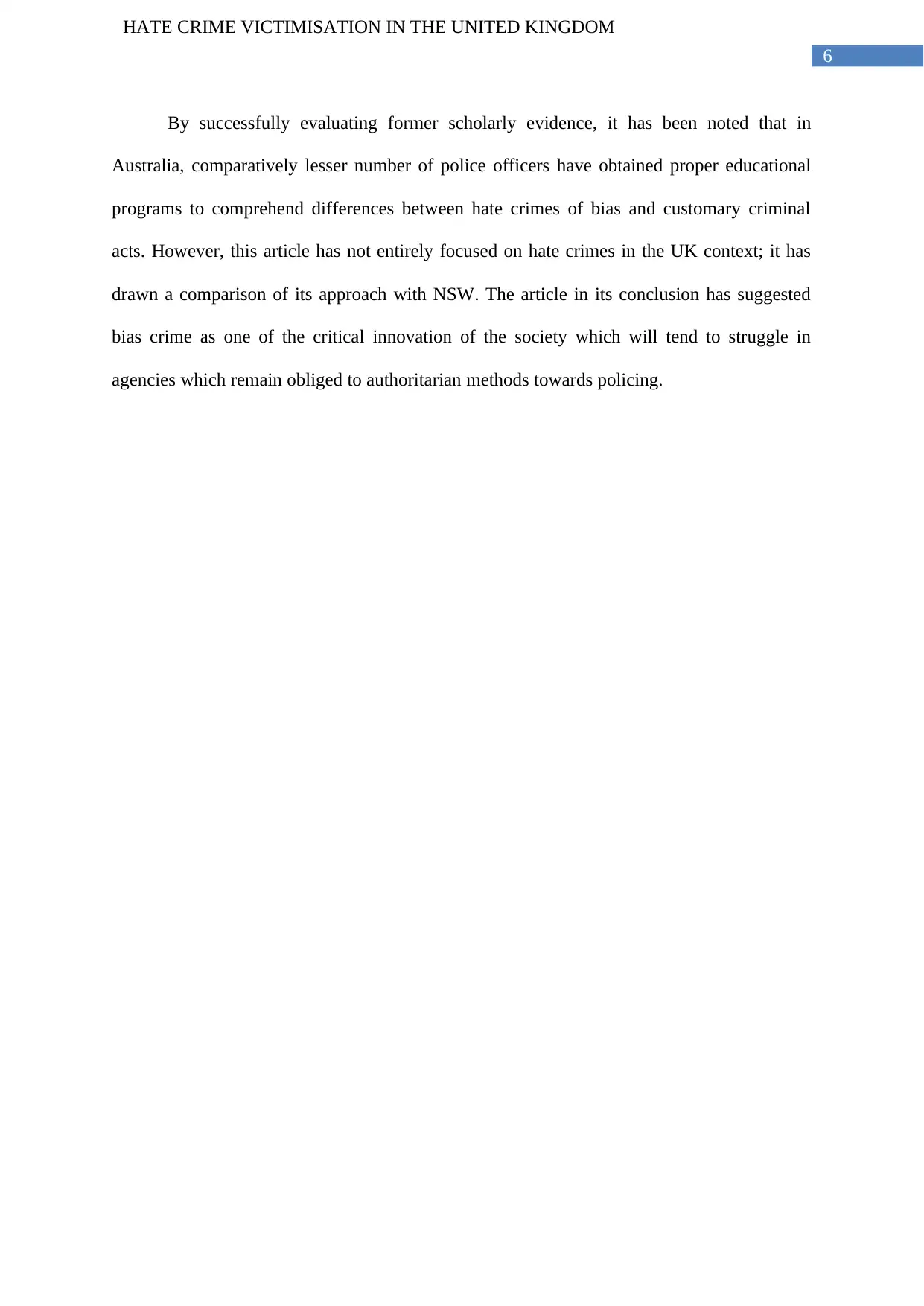
6
HATE CRIME VICTIMISATION IN THE UNITED KINGDOM
By successfully evaluating former scholarly evidence, it has been noted that in
Australia, comparatively lesser number of police officers have obtained proper educational
programs to comprehend differences between hate crimes of bias and customary criminal
acts. However, this article has not entirely focused on hate crimes in the UK context; it has
drawn a comparison of its approach with NSW. The article in its conclusion has suggested
bias crime as one of the critical innovation of the society which will tend to struggle in
agencies which remain obliged to authoritarian methods towards policing.
HATE CRIME VICTIMISATION IN THE UNITED KINGDOM
By successfully evaluating former scholarly evidence, it has been noted that in
Australia, comparatively lesser number of police officers have obtained proper educational
programs to comprehend differences between hate crimes of bias and customary criminal
acts. However, this article has not entirely focused on hate crimes in the UK context; it has
drawn a comparison of its approach with NSW. The article in its conclusion has suggested
bias crime as one of the critical innovation of the society which will tend to struggle in
agencies which remain obliged to authoritarian methods towards policing.
Paraphrase This Document
Need a fresh take? Get an instant paraphrase of this document with our AI Paraphraser
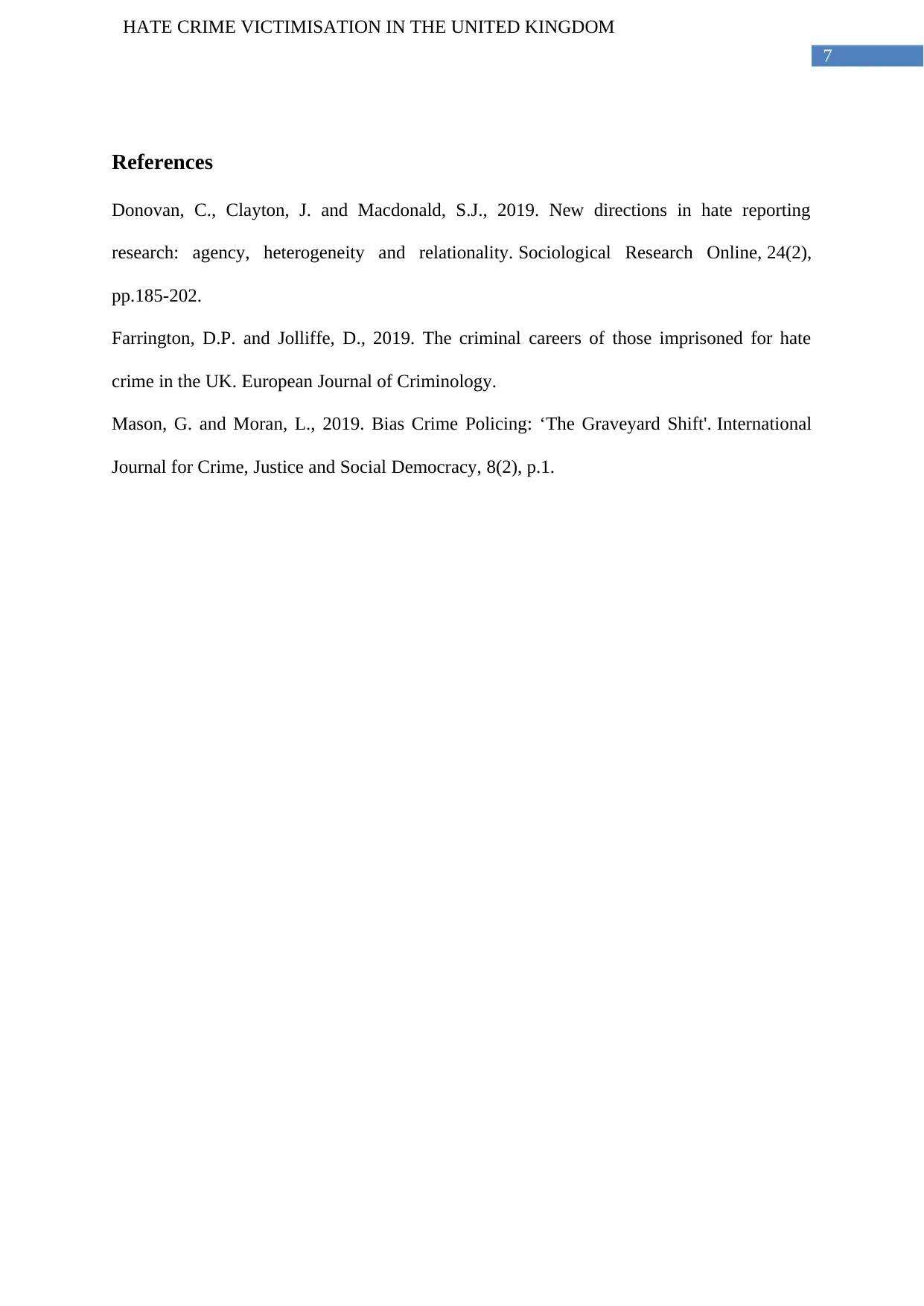
7
HATE CRIME VICTIMISATION IN THE UNITED KINGDOM
References
Donovan, C., Clayton, J. and Macdonald, S.J., 2019. New directions in hate reporting
research: agency, heterogeneity and relationality. Sociological Research Online, 24(2),
pp.185-202.
Farrington, D.P. and Jolliffe, D., 2019. The criminal careers of those imprisoned for hate
crime in the UK. European Journal of Criminology.
Mason, G. and Moran, L., 2019. Bias Crime Policing: ‘The Graveyard Shift'. International
Journal for Crime, Justice and Social Democracy, 8(2), p.1.
HATE CRIME VICTIMISATION IN THE UNITED KINGDOM
References
Donovan, C., Clayton, J. and Macdonald, S.J., 2019. New directions in hate reporting
research: agency, heterogeneity and relationality. Sociological Research Online, 24(2),
pp.185-202.
Farrington, D.P. and Jolliffe, D., 2019. The criminal careers of those imprisoned for hate
crime in the UK. European Journal of Criminology.
Mason, G. and Moran, L., 2019. Bias Crime Policing: ‘The Graveyard Shift'. International
Journal for Crime, Justice and Social Democracy, 8(2), p.1.
1 out of 8
Your All-in-One AI-Powered Toolkit for Academic Success.
+13062052269
info@desklib.com
Available 24*7 on WhatsApp / Email
![[object Object]](/_next/static/media/star-bottom.7253800d.svg)
Unlock your academic potential
Copyright © 2020–2025 A2Z Services. All Rights Reserved. Developed and managed by ZUCOL.


